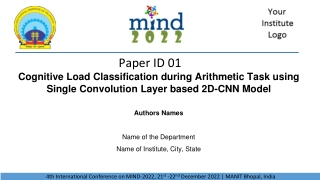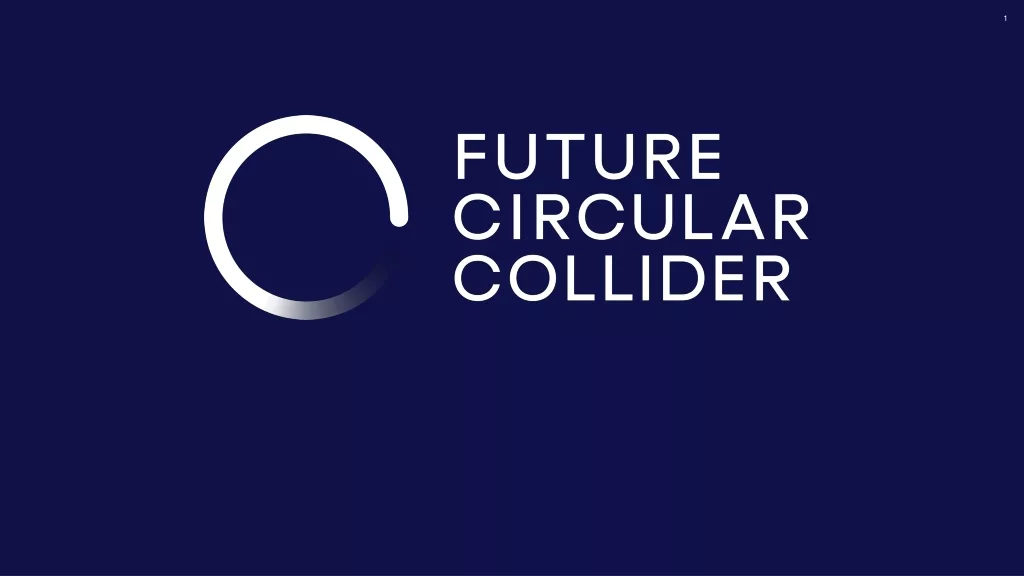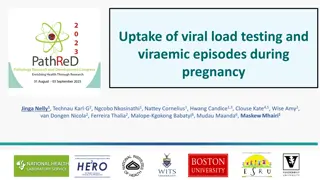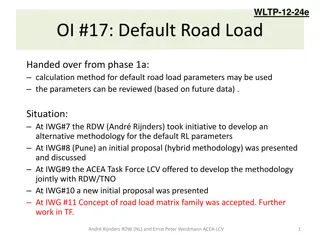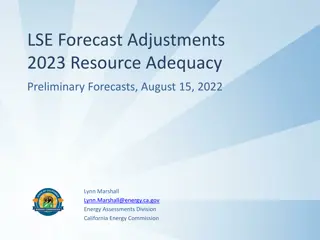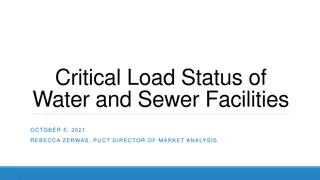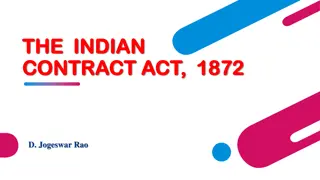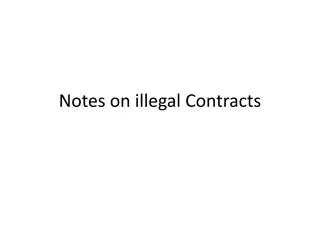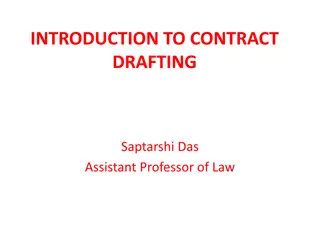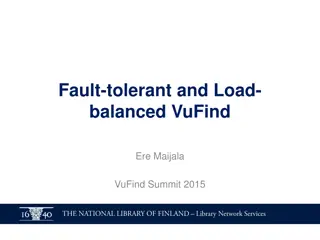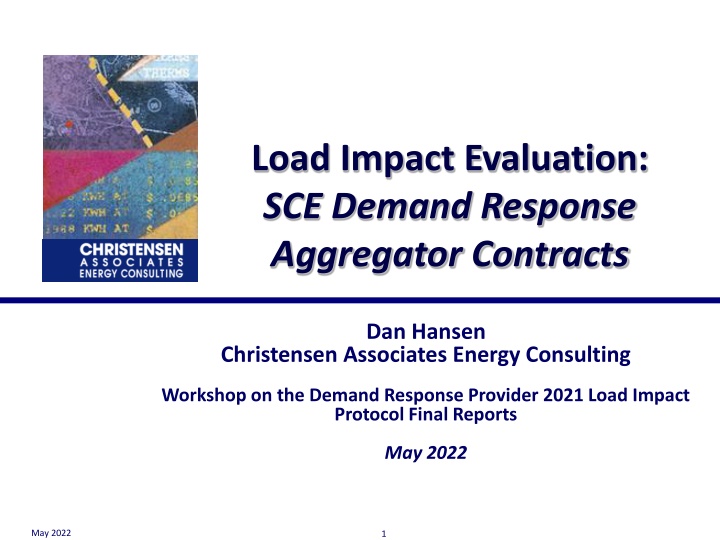
SCE Demand Response Aggregator Contracts & Impacts
Explore the impact evaluation of SCE demand response aggregator contracts conducted by Dan Hansen Christensen Associates. The workshop delves into the methodology and findings of both ex-post and ex-ante load impacts, shedding light on the operations of DRAs like Hybrid Electric Building Technologies, Stem Energy, and NRG Curtailment Solutions. Discover the maximum capacity of DRA contracts for 2021 and insights into the customer-specific regression models used in the analysis.
Download Presentation

Please find below an Image/Link to download the presentation.
The content on the website is provided AS IS for your information and personal use only. It may not be sold, licensed, or shared on other websites without obtaining consent from the author. If you encounter any issues during the download, it is possible that the publisher has removed the file from their server.
You are allowed to download the files provided on this website for personal or commercial use, subject to the condition that they are used lawfully. All files are the property of their respective owners.
The content on the website is provided AS IS for your information and personal use only. It may not be sold, licensed, or shared on other websites without obtaining consent from the author.
E N D
Presentation Transcript
Load Impact Evaluation: SCE Demand Response Aggregator Contracts Dan Hansen Christensen Associates Energy Consulting Workshop on the Demand Response Provider 2021 Load Impact Protocol Final Reports May 2022 May 2022 1
Presentation Outline 1. Resource Description 2. Ex-post Methodology 3. Ex-post Load Impacts 4. Ex-ante Methodology 5. Ex-ante Load Impacts May 2022 2
1. Resource Description Three Demand Response Aggregators (DRAs) had active contracts during 2021: Hybrid Electric Building Technologies (Hybrid) Stem Energy (Stem) NRG Curtailment Solutions (NRG) The DRAs enrolled commercial and industrial customers to provide demand response within SCE s service territory DRAs nominate customers on a monthly basis SCE dispatched the contracts according to the associated terms DRA is responsible for meeting the contract obligations Two additional DRAs have contracted with SCE for upcoming years: Swell Energy (Swell): two contracts beginning in 2022 Sunrun Inc. (Sunrun): two contracts beginning in 2023 May 2022 3
1. Resource Description: Maximum Capacity for 2021 DRA Contracts Total Contract Capacity (MW) Month Hybrid Stem NRG Total 8 to 10 a.m. 50 0 0 50 10 a.m. to 6 p.m. 50 20 5 75 6 to 8 p.m. 33.5 20 5 58.5 8 to 9 p.m. 33.5 20 0 53.5 May 2022 4
2. Ex-post Methodology Estimated customer-specific regression models with the customer s hourly usage as the dependent variable Models are used to simulate reference loads that would have occurred in the absence events The explanatory variables include: Temperatures, expressed in several ways (e.g., current hour, average daily, maximum daily) Hour of day Day of week Month of year A morning load variable (average load from midnight to 10 a.m., except for customers with early event hours) May 2022 5
2. Ex-post Methodology (2) Data included in the model November 2020 through September 2021 Exclude event hours plus at least 3 hours following the event If the event starts at 5 p.m. or later, the rest of the day is excluded Needed to include some event-day data to improve estimates for contracts with a high frequency of events Exclude data prior to the customer s first nominated month, which ensures that storage is in place (if applicable) Model validation Estimated a common specification excluding ~12% of the data (randomly selected non-event days) Compared predicted and observed values on withheld days and adjusted the customer s regression specification as needed Estimated load impact = the model s predicted load for the event hour minus the observed load May 2022 6
3. Ex-post Results Average Event Hour with Full Dispatch A B C D E F G Average Contract Amount (MW) % of Contract Amount (E / C) Avg. Avg. Event Hours Reference Load (MW) Load Impact (MW) % Date Customers Dispatched Impact (E / D) Load Impact = our estimate of the difference between observed loads and the loads that would have occurred in the absence of the event % Impact = Load Impact / Reference Load % of Contract Amount = Load Impact / Contract Amount Includes only event hours with all resources dispatched within a contract 6/15 330 5-7 p.m. 66.8 168.7 71.3 42% 107% 6/16 330 5-8 p.m. 64.0 161.9 67.2 41% 105% 6/17 330 5-8 p.m. 64.0 159.2 71.4 45% 112% 6/18 330 6-8 p.m. 58.5 152.4 61.0 40% 104% 7/9 328 6-8 p.m. 58.5 159.9 69.2 43% 118% 7/12 328 6-8 p.m. 58.5 148.5 65.9 44% 113% 7/13 327 6-8 p.m. 58.5 159.0 68.5 43% 117% 7/19 327 6-8 p.m. 58.5 154.6 71.6 46% 122% 7/28 327 5-8 p.m. 64.0 158.2 68.0 43% 106% 7/29 327 5-8 p.m. 64.0 156.5 72.7 46% 114% 9/8 325 5-7 p.m. 66.8 163.9 71.2 43% 107% 9/9 325 5-7 p.m. 66.8 162.6 68.2 42% 102% May 2022 7
3. Ex-post Results July 28, 2021 Hourly Load Impacts Blue shading = Full dispatch hours Green shading = Partial dispatch hours Red shading = Contract quantities May 2022 8
4. Ex-ante Methodology SCE provided a forecast of monthly capacity commitments by contract Replaces the enrollment forecast typically used in a load impact study Simulate customer-specific reference loads for all required scenarios (by month and weather scenario) Same as ex-post regression model but omitting the morning load variable May 2022 9
4. Ex-ante Methodology: Contracts in the Ex-Post Study Ex-ante load impacts are a straightforward translation of the ex-post estimates No weather effect on load impacts, so no statistical modeling is needed Forecast is drawn from corresponding observed hours, e.g., HE 17 ex- post impacts are used to forecast HE 17 ex-ante impacts Hourly forecast impacts are built up from dispatch ID-level estimates (allows us to use all events and not just full-dispatch events) Contracts have a maximum 4-hour event duration, whereas the Resource Adequacy window is 5 hours long Simulate all 5 hours to reflect the resource s potential in each hour of the RA window Forecast contract quantities matched ex-post contract quantities, so no adjustment was needed for that May 2022 10
4. Ex-ante Methodology: Contracts NOT in the Ex-Post Study For contracts not in the ex-post study, we have no customer load data or historical performance upon which to base the ex-ante forecast We follow the assumption from the previous evaluation, applying an assumed percentage to the contract value to forecast the load impacts that will be provided May 2022 11
5. Ex-ante Load Impacts: Forecast Contract Quantities (MW) Month 2022 2023 2024 2025 Jan Feb Mar Apr May Jun Jul Aug Sep Oct Nov Dec 61.9 61.9 62.0 62.0 62.1 62.9 64.6 64.7 64.7 64.4 64.4 66.7 69.4 69.3 70.1 70.1 70.5 71.2 72.0 77.2 77.1 76.5 76.3 75.0 77.9 77.7 78.8 78.9 79.4 79.6 80.0 80.2 80.1 79.4 79.1 77.5 79.3 78.1 78.3 78.4 78.5 82.1 83.6 83.8 81.8 79.8 79.3 79.5 May 2022 12
5. Ex-ante Load Impacts: Average August RA Window Impacts (MW) May 2022 13
5. Ex-ante Load Impacts: August 2022 SCE 1-in-2 Impacts (MW) Figure reflects only contracts included in the ex-post study May 2022 14
Questions? Contact Dan Hansen Christensen Associates Energy Consulting Madison, Wisconsin dghansen@CAEnergy.com (608)231-2266 May 2022 15

